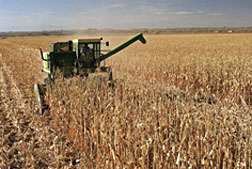Sustainable Corn Production Supports Advanced Biofuel Feedstocks

(PhysOrg.com) -- Researchers worldwide are trying to economically convert cellulosic biomass such as corn stover into "cellulosic ethanol." But Agricultural Research Service (ARS) scientists have found that it might be more cost-effective, energy-efficient and environmentally sustainable to use corn stover for generating an energy-rich oil called bio-oil and for making biochar to enrich soils and sequester carbon.
Stover is made up of the leaves, husks, cobs and stalks of the corn plant, and could provide an abundant source of feedstock for cellulosic ethanol production after the grain is harvested. But removing stover from the field would leave soil more vulnerable to erosion, deplete plant nutrients and accelerate the loss of soil organic matter.
Several ARS scientists collaborated with the National Corn Growers Association to explore other options for using corn stover as biofuel feedstock. Chemical engineer Akwasi Boateng, chemist Charles Mullen, mechanical engineer Neil Goldberg and research leader Kevin Hicks all work at the ARS Eastern Regional Research Center in Wyndmoor, Pa. Chemist Isabel Lima, who works at the ARS Southern Regional Research Center in New Orleans, La.; and soil scientist David Laird, who works at the ARS National Laboratory for Agriculture and the Environment in Ames, Iowa, also contributed to the study.
The team used fast pyrolysis, which is rapid heating in the absence of oxygen, to transform corn stover and cobs into bio-oil and bio-char. They found that the bio-oil captured 70 percent of the total energy input, and the energy density of the bio-oil was five to 16 times the energy density of the feedstock.
This suggests it could be more cost-effective to produce bio-oil through a distributed network of small pyrolyzers and then transport the crude bio-oil to central refining plants to make "green gasoline," rather than transporting bulky stover to a large centralized cellulosic ethanol plant.
In addition, about 18 percent of the feedstock was converted into bio-char, which contains most of the mineral nutrients in the corn residues. Using biochar as a soil amendment would return those nutrients to the soil, reduce leaching of other nutrients, help build soil organic matter and sequester carbon. These benefits would help mitigate the adverse environmental effects of harvesting stover for fuel production.
These findings were published online in the journal Biomass and Bioenergy.
Provided by USDA Agricultural Research Service

















